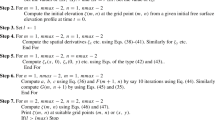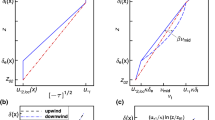Abstract
This paper is concerned with the prediction of mass and momentum transport in turbulent wall jets developing over smooth and transitionally rough plane walls. The ability to accurately predict the resulting wall shear stresses and vertical profiles of the Reynolds stresses in these flows is prerequisite to the accurate prediction of bed scour, sediment re-suspension and transport by turbulent diffusion. The computations were performed by solving the Reynolds-averaged forms of the equations describing conservation of mass, momentum and concentration. The unknown correlations that arise from the averaging process (the Reynolds stresses in the case of the momentum equation, and the turbulent mass fluxes in the case of concentration) were obtained from the solution of modeled differential equations that describe their conservation. Since these models are somewhat more complex than those typically used in practice, their benefits are demonstrated by comparisons with results obtained from simpler, eddy-viscosity based closures. Comparisons with experimental data show that results of acceptable accuracy can be obtained only by using the appropriate combination of models for the turbulent fluxes of mass and momentum that properly account for the reduction of the Reynolds stresses due to wall damping effects, and for the modification of the mass transfer rates due to interactions with the mean rates of strain.










Similar content being viewed by others
References
Rastello M, Hopfinger EJ (2004) Sediment-entraining suspension clouds: a model of powder-snow avalanches. J Fluid Mech 509:181–206. doi:10.1017/S0022112004009322
Etienne J, Rastello M, Hopfinger EJ (2006) Modelling and simulation of powder-snow avalanches. C R Mécanique 334:545–554. doi:10.1016/j.crme.2006.07.010
Kneller B, Buckee C (2000) The structure and fluid mechanics of turbidity currents: a review of some recent studies and their geological implications. Sedimentology 47:62–94
Gray TE, Alexander J, Leeder MR (2005) Quantifying velocity and turbulence structure in depositing sustained turbidity currents across breaks in slope. Sedimentology 52:467–488
Mazurek KA, Rajaratnam N, Sego DC (2003) Scour of a cohesive soil by submerged plane turbulent wall jets. J Hydraul Res 41:195–206
Rajaratnam N (1981) Erosion by plane turbulent jets. J Hydraul Res 19:339–358
Hogg AJ, Huppert HE, Dade WB (1997) Erosion by planar turbulent wall jets. J Fluid Mech 338:317–340. doi:10.1017/S0022112097005077
Barenblatt GI, Chorin AJ, Prostokishin VM (2005) The turbulent wall jet: a triple-layered structure and incomplete similarity. Proc Nat Acad Sci 102:8850–8853. doi:10.1073/pnas.0503186102
Gibson MM, Younis BA (1982) Modelling the curved turbulent wall jet. AIAA J 20:1707–1772
Albayrak I, Hopfinger EJ, Lemmin U (2008) Near-field flow structure of a confined wall jet on flat and concave rough walls. J Fluid Mech 606:27–49
Irwin HPAH (1973) Measurements in a self-preserving plane wall jet in a positive pressure gradient. J Fluid Mech 61:33–63. doi:10.1017/S0022112073000558
Daly BJ, Harlow FH (1970) Transport equations in turbulence. Phys Fluids 13:2634–2649. doi:10.1063/1.1692845
Younis BA, Speziale CG, Berger S (1998) Accounting for effects of a system rotation on the pressure-strain correlation. AIAA J 36:1746–1748
Gibson MM, Launder BE (1978) Ground effects on pressure fluctuations in the atmospheric boundary layer. J Fluid Mech 86:491–511. doi:10.1017/S0022112078001251
Speziale CG, Sarkar S, Gatski TB (1991) Modeling the pressure-strain correlation of turbulence: an invariant dynamical systems approach. J Fluid Mech 227:245–272. doi:10.1017/S0022112091000101
Dafalias YF, Younis BA (2009) Objective model for the fluctuating pressure-strain-rate correlations. J Eng Mech 135:1006–1014. doi:10.1061/(ASCE)EM.1943-7889.0000014
Malin MR, Younis BA (1990) Calculation of turbulent bouyant plumes with a Reynolds stress and heat flux transport closure. Int J Heat Mass Trans 33:2247–2264. doi:10.1016/0017-9310(90)90124-D
Monin AS (1965) On the symmetry properties of turbulence in the surface layer of air. Izvestya Atmos Ocean Phys 1:45–54
Yoshizawa A (1988) Statistical modelling of passive-scalar diffusion in turbulent shear flows. J Fluid Mech 195:541–555. doi:10.1017/S0022112088002514
Rubinstein R, Barton JM (1991) Renormalization group analysis of anisotropic diffusion in turbulent shear flows. Phys Fluids 3:415–421. doi:10.1063/1.858097
Younis BA, Speziale CG, Clark TT (2005) A rational model for the turbulent scalar fluxes. Proc R Soc A 461:575–594. doi:10.1098/rspa.2004.1380
Kaltenbach HJ, Gerz T, Schumann U (1994) Large-eddy simulation of homogeneous turbulence and diffusion in stably stratified shear flow. J Fluid Mech 280:1–40. doi:10.1017/S0022112094002831
Tachie MF, Balachandar R, Bergstrom DJ (2002) Scaling the inner region of turbulent plane wall jets. Exp Fluids 33:351–354. doi:10.1007/s00348-002-0451-6
Eriksson JG, Karlsson RI, Persson J (1998) An experimental study of a two-dimensional plane turbulent wall jet. Exp Fluids 25:50–60. doi:10.1007/s003480050207
Nikuradse J (1933) Strömungsgesetze in rauhen Rohren. VDI-Forschungsheft 361
Brzek B, Bailon-Cuba J, Leonardi S, Castillo L (2009) Theoretical evaluation of the Reynolds shear stress and flow parameters in transitionally rough turbulent boundary layers. J Turbul 10:1–28. doi:10.1080/14685240802524392
George WK, Castillo L (2009) Zero-pressure-gradient turbulent boundary layer. Appl Mech Rev 50:689–729. doi:10.1115/1.3101858
Rostamy N, Bergstrom DJ, Sumner D, Bugg JD (2011) An experimental study of a turbulent wall jet on smooth and transitionally rough surfaces. J Fluids Eng 133:111207. doi:10.1115/1.4005218
Younis BA (1996) EXPRESS: accelerated parabolic Reynolds stress solver. Hydraulics section report HDBAY1, City University, London
Launder BE, Rodi W (1981) The turbulent wall jet. Prog Aero Sci 19:81–128
George WK, Abrahamsson H, Eriksson J, Karlsson RI, Lofdahl L, Wosnik M (2000) A similarity theory for the turbulent plane wall jet without external stream. J Fluid Mech 425:367–411. doi:10.1017/S002211200000224X
Abrahamsson H, Johansson AV, Löfdahl L (1994) A turbulent plane 2-dimensional wall jet in a quiescent surrounding. Eur J Mech B Fluids 13:533–556
Bradshaw P, Gee MT (1960) Turbulent wall jets with and without an external stream. Aero R Council R&M 3252
Mabuchi I, Kumada M (1972) Studies on heat transfer to turbulent jets with adjacent boundaries. I. Flow development and mass transfer in plane turbulent wall jet. Bull JSME 15:1236–1245
Goldstein RJ, Cho HH (1995) A review of mass transfer measurements using naphthalene sublimation. Exp Therm Fluid Sci 10:416–434. doi:10.1016/0894-1777(94)00071-F
Younis BA, Gatski T, Speziale CG (1996) Assessment of the SSG pressure-strain model in free turbulent jets with and without swirl. J Fluid Eng 118:800–809
Wygnanski I, Katz Y, Horev E (1992) On the applicability of various scaling laws to the turbulent wall jet. J Fluid Mech 234:669–690. doi:10.1017/S002211209200096X
Acknowledgments
M. Zumdick gratefully acknowledges the financial support provided by the Hermann-Reissner-Stiftung to support his stay at the University of California, Davis.
Author information
Authors and Affiliations
Corresponding author
Appendix: Numerical accuracy
Appendix: Numerical accuracy
Grid-independence tests were performed with the number of cross-stream nodes varied by a factor of 3 viz. 30, 60 and 90. The differences between the results obtained with the finest and the coarsest grids was of the order of 1 % (e.g. the jet’s spreading rate, a sensitive parameter whose value is detemined by the details of the turbulence field, was predicted with the 30 nodes simulations to be 0.079 and with the 90 nodes simulations to be 0.078). The reasons for such small dependence of the computed results on the grid arise from the fact that the flow is uni-directional and is thus largely free of the interpolation errors that arise when the flow streamlines are not aligned with the grid lines. Indeed the computational grid is designed so as to adapt to the physical extent of the flow and in this way remain aligned with the streamlines, and with all the cross-stream nodes always located within the flow.
Quantification of the degree of correspondence between the predictions and the measurements of Eriksson et al. [24] is presented in Table 4 for the maximum values of the Reynolds stresses at three streamwise locations, and in Fig. 11 for the cross-stream profiles of streamwise velocity. Undoubtly some of the observed differences arise from shortcomings in the models but it should also be noted that the experimental results themselves are subject to uncertainties. In this regard, it is interesting to note that all the models yield differences that are positive in sign which may suggest that the measurements underestimate the actual values to some extent. Figure 11 also shows that the percentage differences decrease markedly with distance from the nozzle exit. This is to be expected considering that the starting profiles for the computations had to be assumed due to the absence of measurements there.
Cross-stream variation of relative differences beween predicted and measured mean velocity. Data of Eriksson et al. [24]
Rights and permissions
About this article
Cite this article
Younis, B.A., Zumdick, M. & Weigand, B. Prediction of mass and momentum transport in turbulent plane wall jets over smooth and transitionally rough surfaces. Environ Fluid Mech 16, 485–502 (2016). https://doi.org/10.1007/s10652-015-9431-2
Received:
Accepted:
Published:
Issue Date:
DOI: https://doi.org/10.1007/s10652-015-9431-2





